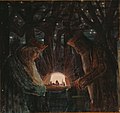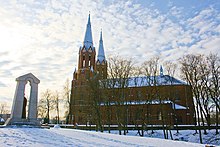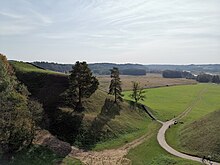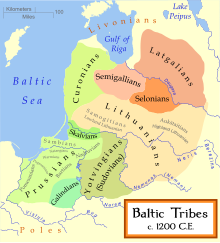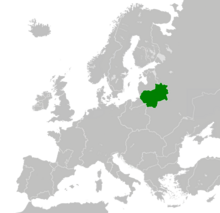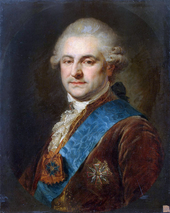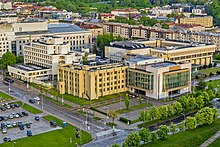Template:Transclude list item excerpts as random slideshow/testcases/Portal:Lithuania
| This is the template test cases page for the sandbox of Template:Transclude list item excerpts as random slideshow/testcases. Purge this page to update the examples. If there are many examples of a complicated template, later ones may break due to limits in MediaWiki; see the HTML comment "NewPP limit report" in the rendered page. You can also use Special:ExpandTemplates to examine the results of template uses. You can test how this page looks in the different skins and parsers with these links: |
Portal maintenance status: (June 2018)
|
Introduction
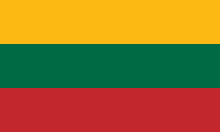
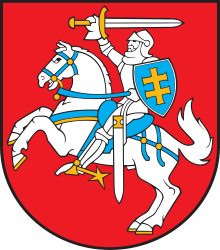
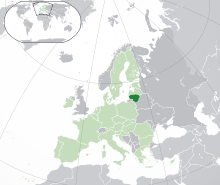
Lithuania, officially the Republic of Lithuania, is a country in the Baltic region of Europe. It is one of three Baltic states and lies on the eastern shore of the Baltic Sea, bordered by Latvia to the north, Belarus to the east and south, Poland to the south, and the Russian semi-exclave of Kaliningrad Oblast to the southwest, with a maritime border with Sweden to the west. Lithuania covers an area of 65,300 km2 (25,200 sq mi), with a population of 2.88 million. Its capital and largest city is Vilnius; other major cities include Kaunas, Klaipėda, Šiauliai and Panevėžys. Lithuanians belong to the linguistic group of the Balts and speak Lithuanian.
For millennia, the southeastern shores of the Baltic Sea were inhabited by various Baltic tribes. In the 1230s, Lithuanian lands were united for the first time by Mindaugas, who formed the Kingdom of Lithuania on 6 July 1253. Subsequent expansion and consolidation resulted in the Grand Duchy of Lithuania, which by the 14th century was the largest country in Europe. In 1386, the Grand Duchy entered into a de facto personal union with the Crown of the Kingdom of Poland. The two realms were united into the bi-confederal Polish-Lithuanian Commonwealth in 1569, forming one of the largest and most prosperous states in Europe. The Commonwealth lasted more than two centuries, until neighbouring countries gradually dismantled it between 1772 and 1795, with the Russian Empire annexing most of Lithuania's territory.
Towards the end of World War I, Lithuania declared Independence in 1918, founding the modern Republic of Lithuania. In World War II, Lithuania was occupied by the Soviet Union, then by Nazi Germany, before being reoccupied by the Soviets in 1944. Lithuanian armed resistance to the Soviet occupation lasted until the early 1950s. On 11 March 1990, a year before the formal dissolution of the Soviet Union, Lithuania became the first Soviet republic to break away when it proclaimed the restoration of its independence. (Full article...)
Selected pictures
-
Image 2Simple Words of Catechism by Martynas Mažvydas was the first Lithuanian book and was published in 1547. (from Culture of Lithuania)
-
Image 4The title page of Radivilias (1592, Vilnius). The poem celebrating commander Mikalojus Radvila Rudasis (1512–1584) and recounts the famous victory of Lithuanian Armed Forces over Moscow troops (1564). (from Lithuania)
-
Image 7Major highways in Lithuania (from Lithuania)
-
Image 8Emilia Plater leading peasant scythemen during the 1831 Uprising against Russian Empire; often nicknamed as a Lithuanian Joan of Arc (from Lithuania)
-
Image 9Lithuania men's national basketball team is ranked eighth worldwide in FIBA Rankings. (from Lithuania)
-
Image 10Guests of the 2023 Vilnius (NATO) summit in the Courtyard of the Presidential Palace in Vilnius (from Lithuania)
-
Image 11The first Lithuanian printed book, Catechism of Martynas Mažvydas (1547, Königsberg) (from Lithuania)
-
Image 15Population density of Lithuania (from Lithuania)
-
Image 16The earliest known Lithuanian glosses (between 1520 and 1530) written in the margins of Johann Herolt book Liber Discipuli de eruditione Christifidelium. Words: teprÿdav[ſ]ʒÿ (let it strike), vbagÿſte (indigence). (from Lithuania)
-
Image 17The white stork is the national bird of Lithuania, which has the highest-density stork population in Europe. (from Lithuania)
-
Image 19Lithuania was a member of the United Nations Security Council. Its representatives are on the right side. (from Lithuania)
-
Image 22Changes in the territory of Lithuania from the 13th to 15th century. At its peak, Lithuania was the largest state in Europe. (from Lithuania)
-
Image 25Lithuanian Army soldiers marching with their dress uniforms in Vilnius. An officer stands out with a sword. (from Lithuania)
-
Image 27Members of the Council of Lithuania after signing the Act of Independence of Lithuania in 1918 (from Lithuania)
-
Image 28Rock band Antis, which under firm censorship actively mocked the Soviet Union regime by using metaphors in their lyrics, during an anti-Sovietism, anti-communism concert in 1987 (from Lithuania)
-
Image 29Real GDP per capita development of Estonia, Latvia and Lithuania (from Lithuania)
-
Image 33Lithuania's name in writing (Litua, on line 7), 1009 (from Lithuania)
-
Image 37Lithuanian counties by GDP per capita, 2022 (from Lithuania)
-
Image 38Traditional Lithuanian house from late 19th century (from Culture of Lithuania)
-
Image 43Commemoration of the Act of the Re-Establishment of the State of Lithuania in the historical Seimas hall where it was originally signed in 1990. The ceremony is attended by the Lithuanian President, Prime Minister, Chairman of the Seimas and other high-ranking officials. (from Lithuania)
-
Image 44Physical map and geomorphological subdivision of Lithuania (from Lithuania)
-
Image 48Cepelinai served with sour cream (from Culture of Lithuania)
-
Image 49Le Château — Conte de fées (Lithuanian: Pilis — Pasaka) by Mikalojus Konstantinas Čiurlionis (1909) (from Culture of Lithuania)
-
Image 52Baltic amber was a valuable trade item, transported from the region of modern-day Lithuania to the Roman Empire through the Amber Road. (from Lithuania)
-
Image 53Statutes of Lithuania were the central piece of Lithuanian law in 1529–1795. (from Lithuania)
-
Image 56Lithuanian artist Jonas Mekas, regarded as godfather of American avant-garde cinema (from Culture of Lithuania)
-
Image 59Gryčia (traditional dwelling house, built in the 19th century) (from Lithuania)
-
Image 61Panorama of Vilnius in 1600 (from Lithuania)
-
Image 62Cepelinai, a potato-based dumpling dish characteristic of Lithuanian cuisine with meat, curd or mushrooms (from Lithuania)
-
Image 68Lithuanian cemetery at All Souls night (from Culture of Lithuania)
-
Image 71Chapel of Saint Casimir, the patron saint of Lithuania and Lithuanian youth, with his sarcophagus in the centre (from Lithuania)
-
Image 73Vilnius University, one of the oldest universities in the region. It was established by Stephen Báthory, King of Poland and Grand Duke of Lithuania, in 1579. (from Lithuania)
-
Image 75Lithuanian basketball clubs Žalgiris and Šiauliai playing a match (from Culture of Lithuania)
-
Image 79Trakai Island Castle, the former residence of the Grand Dukes. Trakai was the capital of the medieval state. (from Lithuania)
-
Image 82The Great Courtyard of Vilnius University and the Church of St. Johns (from Culture of Lithuania)
-
Image 83Lithuania's GDP per capita compared to rest of the world (2022) (from Lithuania)
-
Image 84Stamp dedicated to Lithuania's presidency of the European Union. Post of Lithuania, 2013. (from Lithuania)
-
Image 87A ceremony of Lithuanian modern pagans. (from Culture of Lithuania)
Selected county
-
Image 1
Panevėžys County (Lithuanian: Panevėžio apskritis) is one of ten counties in Lithuania. It is in the north-east of the country, and its capital is Panevėžys. On 1 July 2010, the county administration was abolished, and since that date, Panevėžys County remains as the territorial and statistical unit. (Full article...) -
Image 2
Vilnius County (Lithuanian: Vilniaus apskritis) is the largest of the 10 counties of Lithuania, located in the east of the country around the city Vilnius and is also known as Capital Region or Sostinės regionas by the Lithuanian statistics department and Eurostat. On 1 July 2010, the county administration was abolished, and since that date, Vilnius County remains as the territorial and statistical unit. (Full article...) -
Image 3
Utena County (Lithuanian: Utenos Apskritis) is one of ten counties in Lithuania. It is the country's most sparsely populated county. The capital and the largest city in the county is Utena, which is 95 km (59 mi) from Vilnius, the capital of Lithuania. On 1 July 2010, the county administration was abolished. Since that date, Utena County remains as the territorial and statistical unit. It borders Latvia. (Full article...) -
Image 4
Kaunas County (Lithuanian: Kauno apskritis) is one of ten counties of Lithuania. It is in the centre of the country, and its capital is Kaunas. On 1 July 2010, the county administration was abolished. (Full article...) -
Image 5
Alytus County (Lithuanian: Alytaus apskritis) is one of ten counties in Lithuania. It is the southernmost county, and its capital is the city of Alytus. Its territory lies within the ethnographic region of Dzūkija. On 1 July 2010, the county administration was abolished, and since that date, Alytus County remains as the territorial and statistical unit.
It borders the Vilnius County in the east, Marijampolė County and Kaunas County in the north, Podlaskie Voivodeship of Poland in the west, and Grodno Region of Belarus in the south. (Full article...) -
Image 6
Šiauliai County (Lithuanian: Šiaulių apskritis) is one of ten counties in Lithuania. It is in the north of the country, and its capital is Šiauliai. On 1 July 2010, the county administration was abolished, and since that date, Šiauliai County remains as the territorial and statistical unit. It borders Latvia. (Full article...) -
Image 7
Tauragė County (Lithuanian: Tauragės apskritis) is one of ten counties in Lithuania. It is in the west of the country, and its capital is Tauragė. On 1 July 2010, the county administration was abolished, and since that date, Tauragė County remains as the territorial and statistical unit.
Famous landmarks include Tauragė Castle and Panemunė Castle. (Full article...) -
Image 8
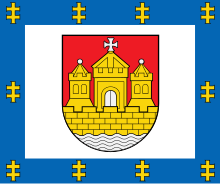
Klaipėda County (Lithuanian: Klaipėdos apskritis) is one of ten counties in Lithuania, bordering Tauragė County to the southeast, Telšiai County to the northeast, Kurzeme in Latvia to the north, and Kaliningrad Oblast in Russia to the south. To the west is the Baltic Sea. It lies in the west of the country and is the only county to have a coastline and not be landlocked. Its capital is Klaipėda. On 1 July 2010, the county administration was abolished, and since that date, Klaipėda County remains as the territorial and statistical unit. (Full article...) -
Image 9
Telšiai County (Lithuanian: Telšių apskritis) is one of ten counties in Lithuania. It is in the west of the country, and its capital is Telšiai. There are Lithuanians (98.7%), Latvians (0.1%), Russians (0.9%), and others (0.3%). On 1 July 2010, the county administration was abolished, and since that date, Telšiai County remains as the territorial and statistical unit. It borders Latvia. (Full article...) -
Image 10
Marijampolė County (Lithuanian: Marijampolės apskritis) is one of the ten counties in Lithuania. It is in the southwest of the country and roughly corresponds to the historical region of Sudovia. Its capital and the largest town is Marijampolė. On 1 July 2010, the county administration was abolished, and since that date, Marijampolė County remains as the territorial and statistical unit.
It borders the Tauragė County in the north, Kaunas County and Alytus County in the east, Podlaskie Voivodeship of Poland in the south and Kaliningrad Oblast of Russia in the west. (Full article...)
Selected municipality
-
Image 1Landscape near Rūdaičiai
Kretinga District Municipality is one of 60 municipalities in Lithuania. (Full article...) -
Image 2
-
Image 3Migoniai mound
Pasvalys District Municipality is one of 60 municipalities in Lithuania. (Full article...) -
Image 4Burbiškiai mound
Telšiai District Municipality (Lithuanian: Telšių rajono savivaldybė, Samogitian: Telšiū rajuona savivaldībė) is one of 60 municipalities in Lithuania, containing the city of Telšiai. (Full article...) -
Image 5
Joniškis District Municipality (Joniškio rajono savivaldybė) is a territorial unit of Lithuania with a population of about 30,000. The administrative center of the municipality is the city of Joniškis. (Full article...) -
Image 6Kupa is a river flowing through Kupiškis
Kupiškis District Municipality is one of 60 municipalities in Lithuania. (Full article...) -
Image 7
Neringa () or Neringa Municipality (Lithuanian: Neringos savivaldybė) is a municipality of Klaipėda County in westernmost Lithuania, comprising several villages in the Curonian Spit. In terms of population, it is the smallest municipality of the country. Nida is the seat of government and largest town in Neringa Municipality. (Full article...) -
Image 8
-
Image 9
Šalčininkai District Municipality (Lithuanian: Šalčininkų rajono savivaldybė, Polish: Rejon solecznicki) is one of 60 district municipalities in Lithuania. The municipality is part of the Vilnius County and is located in southeastern Lithuania, next to the Belarus–Lithuania border. The south-eastern border of the municipality with Belarus includes a distinctive salient of Lithuanian territory, known as the Dieveniškės appendix, almost completely surrounded by Belarus.
Šalčininkai is the largest town and the administrative center of the district with its newly built quarters, while the second largest town is Eišiškės, a more historical town, which was the center of the district and the largest town before 1972. (Full article...) -
Image 10
Lazdijai District Municipality (Lithuanian: Lazdijų rajono savivaldybė) is a municipality in Alytus County, Lithuania. (Full article...) -
Image 11Landscape near Mikytai
Plungė District Municipality (Lithuanian: Plungės rajono savivaldybė, Samogitian: Plongės rajuona savivaldībė) is one of 60 municipalities in Lithuania. (Full article...) -
Image 12
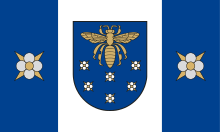
Varėna District Municipality (Lithuanian: Varėnos rajono savivaldybė) is a municipality in Alytus County in southern Lithuania. (Full article...) -
Image 13
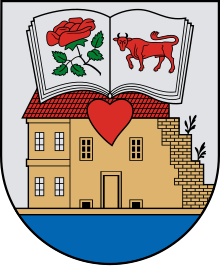
The Ukmergė District Municipality is a municipality in Vilnius County, Lithuania. The capital of the municipality is Ukmergė, the largest settlement and only city in the municipality. The entire municipality belongs to Aukštaitija ethnographic region. (Full article...) -
Image 14
-
Image 15
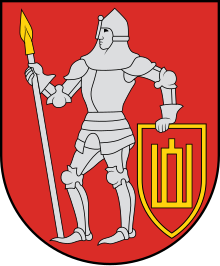
Trakai District Municipality is one of 60 municipalities in Lithuania.
It has significant Polish minority population in Lithuania, with more than quarter of the population claiming Polish ethnicity. (Full article...)
Selected World Heritage Site
-
Image 1
Kaunas (/ˈkaʊnəs/; Lithuanian: [ˈkɐʊ̯ˑnˠɐs] ⓘ; previously known in English as Kovno /ˈkɒvnoʊ/) is the second-largest city in Lithuania after Vilnius, the fourth largest city in the Baltic States and an important centre of Lithuanian economic, academic, and cultural life. Kaunas was the largest city and the centre of a county [pl] in the Duchy of Trakai of the Grand Duchy of Lithuania and Trakai Palatinate since 1413. In the Russian Empire, it was the capital of the Kaunas Governorate from 1843 to 1915.
During the interwar period, it served as the temporary capital of Lithuania, when Vilnius was seized and controlled by Poland between 1920 and 1939. During that period Kaunas was celebrated for its rich cultural and academic life, fashion, construction of countless Art Deco and Lithuanian National Revival architectural-style buildings as well as popular furniture, interior design of the time, and a widespread café culture. The city interwar architecture is regarded as among the finest examples of European Art Deco and has received the European Heritage Label. It contributed to Kaunas being designated as the first city in Central and Eastern Europe as a UNESCO City of Design, and also to becoming a World Heritage Site in 2023 as the only European city representing large scale urbanization during the interwar period and versatile modernism architecture. (Full article...) -
Image 2The Valley of Death looking from the Parnidis Dune in Neringa Municipality, Lithuania in October 2022.
The Curonian (Courish) Spit (Lithuanian: Kuršių nerija; Russian: Ку́ршская коса́) is a 98-kilometre (61 mi) long, thin, curved sand-dune spit that separates the Curonian Lagoon from the Baltic Sea. It is a UNESCO World Heritage Site shared by Lithuania and Russia. Its southern portion lies within Kaliningrad Oblast of Russia, and its northern within southwestern Klaipėda County of Lithuania. (Full article...) -
Image 3
The Old Town of Vilnius (Lithuanian: Vilniaus senamiestis), one of the largest surviving medieval old towns in Northern Europe, as inscribed within Unesco World Heritage sites], has an area of 3.59 square kilometres (887 acres). It encompasses 74 quarters, with 70 streets and lanes numbering 1487 buildings with a total floor area of 1,497,000 square meters. The administrative division of the Old Town (senamiesčio seniūnija) is a larger territory and comprises more than 4.5 square kilometres. It was founded by the Lithuanian Grand Duke and King of Poland Jogaila in 1387 on the Magdeburg rights the oldest part of the Lithuanian capital of Vilnius, it had been developed over the course of many centuries, and has been shaped by the city's history and a constantly changing cultural influence. It is a place where some of Europe's greatest architectural styles—gothic, renaissance, baroque and neoclassical—stand side by side and complement each other. There are many Catholic, Lutheran and Orthodox churches, residential houses, cultural and architectural monuments, museums in the Old Town.
Pilies Street is the Old Town's main artery and the hub of cafe and street market life. The main street of Vilnius, Gediminas Avenue, is partially located in the Old Town. The central squares in the Old Town are the Cathedral Square and the Town Hall Square. (Full article...) -
Image 4The northernmost station of the Struve Geodetic Arc is located in Fuglenes, Norway.
The Struve Geodetic Arc is a chain of survey triangulations stretching from Hammerfest in Norway to the Black Sea, through ten countries and over 2,820 kilometres (1,750 mi), which yielded the first accurate measurement of a meridian arc.
The chain was established and used by the German-born Russian scientist Friedrich Georg Wilhelm von Struve in the years 1816 to 1855 to establish the exact size and shape of the earth. At that time, the chain passed merely through three countries: Norway, Sweden and the Russian Empire. The Arc's first point is located in Tartu Observatory in Estonia, where Struve conducted much of his research. Measurement of the triangulation chain comprises 258 main triangles and 265 geodetic vertices. The northernmost point is located near Hammerfest in Norway and the southernmost point near the Black Sea in Ukraine. (Full article...) -
Image 5
Kernavė was a medieval capital of the Grand Duchy of Lithuania and today is a tourist attraction and an archeological site (population 238, 2021). It is located in the Širvintos district municipality located in southeast Lithuania. A Lithuanian state cultural reserve was established in Kernavė in 1989. In 2004 Kernavė Archaeological Site was included into UNESCO World Heritage list. (Full article...)
Selected history article
-
Image 1
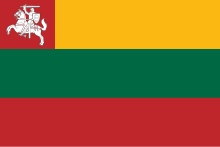
The Kingdom of Lithuania was an attempt to establish an independent constitutional Lithuanian monarchy in February 1918. It was created towards the end of World War I when Lithuanian-speaking lands were under military occupation by the German Empire. The state was officially dissolved in November 1918.
The Council of Lithuania declared Lithuania's independence on 16 February 1918, but the council was unable to form a government, police, or other state institutions due to the continued presence of German troops. The Germans presented various proposals to incorporate Lithuania into the German Empire, particularly Prussia. The Lithuanians resisted this idea and hoped to preserve their independence by creating a separate constitutional monarchy. (Full article...) -
Image 2The history of Lithuania between 1219 and 1295 concerns the establishment and early history of the first Lithuanian state, the Grand Duchy of Lithuania. The beginning of the 13th century marks the end of the prehistory of Lithuania. From this point on the history of Lithuania is recorded in chronicles, treaties, and other written documents. In 1219, 21 Lithuanian dukes signed a peace treaty with Galicia–Volhynia. This event is widely accepted as the first proof that the Baltic tribes were uniting and consolidating. Despite continuous warfare with two Christian orders, the Livonian Order and the Teutonic Knights, the Grand Duchy of Lithuania was established and gained some control over the lands of Black Ruthenia, Polatsk, Minsk, and other territories east of modern-day Lithuania that had become weak and vulnerable after the collapse of Kievan Rus'.
The first ruler to hold the title of Grand Duke was Mindaugas. Traditionally he is considered the founder of the state, the one who united the Baltic tribes and established the Duchy. Some scholars, however, challenge this perception, arguing that an organized state existed before Mindaugas, possibly as early as 1183. After quelling an internal war with his nephews, Mindaugas was baptized in 1251, and was crowned as King of Lithuania in 1253. In 1261, he broke the peace with the Livonian Order, perhaps even renouncing Christianity. His assassination in 1263 by Treniota ended the early Christian kingdom in Lithuania. For another 120 years Lithuania would remain a pagan empire, fighting against the Teutonic and Livonian Orders during the Northern Crusades during their attempts to Christianize the land. (Full article...) -
Image 3

The Polish–Lithuanian Commonwealth, formally known as the Kingdom of Poland and the Grand Duchy of Lithuania and also referred to as Poland–Lithuania or the First Polish Republic, was a federative real union between the Kingdom of Poland and the Grand Duchy of Lithuania, existing from 1569 to 1795. This state was among the largest and most populated countries of 16th- to 17th-century Europe. At its peak in the early 17th century, the Commonwealth spanned nearly 1,000,000 km2 (390,000 sq mi) and supported a multi-ethnic population of approximately 12 million as of 1618. The official languages of the Commonwealth were Polish and Latin, with Catholicism as the state religion.
The Commonwealth was established as a single entity by the Union of Lublin on 1 July 1569. The two nations had previously been in a personal union since the Krewo Agreement of 1385 and the subsequent marriage of Queen Jadwiga of Poland to Grand Duke Jogaila of Lithuania, who was crowned jure uxoris King of Poland. Their descendant, Sigismund II Augustus, enforced the merger to strengthen frontiers of his dominion and maintain unity as he remained childless. His death in 1572 marked the end of the Jagiellonian dynasty and introduced an elective monarchy, whereupon members of domestic noble families or external dynasties were elected to the throne for life. (Full article...) -
Image 4
Yotvingia or Sudovia (Yotvingian: Sūdava, Lithuanian: Dainava, Polish: Jaćwież, German: Sudauen, Eastern Slavic: Яцьвезь (Ятвязь, Етвязь), Ятвягия) was a region where the Baltic tribe known as Yotvingians lived. It was located in the area of Sudovia and Dainava; south west from the upper Nemunas, between Marijampolė, Merkinė (Lithuania), Slonim, Kobryn (Belarus), Białystok, and Ełk (Poland).
Today this area corresponds mostly to the Podlaskie Voivodeship of Poland, part of Lithuania and a part of Hrodna Province and Brest Province of Belarus. (Full article...) -
Image 5
The Soviet occupation of the Baltic states covers the period from the Soviet–Baltic mutual assistance pacts in 1939, to their invasion and annexation in 1940, to the mass deportations of 1941.
In September and October 1939 the Soviet government compelled the much smaller Baltic states to conclude mutual assistance pacts which gave the Soviets the right to establish military bases there. Following invasion by the Red Army in the summer of 1940, Soviet authorities compelled the Baltic governments to resign. The presidents of Estonia and Latvia were imprisoned and later died in Siberia. Under Soviet supervision, new puppet communist governments and fellow travelers arranged rigged elections with falsified results. Shortly thereafter, the newly elected "people's assemblies" passed resolutions requesting admission into the Soviet Union. In June 1941 the new Soviet governments carried out mass deportations of "enemies of the people". Consequently, at first many Balts greeted the Germans as liberators when they occupied the area a week later. (Full article...) -
Image 6The history of the Polish–Lithuanian Commonwealth (1569–1648) covers a period in the history of Poland and Lithuania, before their joint state was subjected to devastating wars in the mid-17th century. The Union of Lublin of 1569 established the Polish–Lithuanian Commonwealth, a more closely unified federal state, replacing the previously existing personal union of the two countries. The Union was largely run by the Polish and increasingly Polonized Lithuanian and Ruthenian nobility, through the system of the central parliament and local assemblies, but from 1573 led by elected kings. The formal rule of the nobility, which was a much greater proportion of the population than in other European countries, constituted a sophisticated early democratic system, in contrast to the absolute monarchies prevalent at that time in the rest of Europe.[a]
The Polish–Lithuanian Union had become an influential player in Europe and a significant cultural entity. In the second half of the 16th and the first half of the 17th century, the Polish–Lithuanian Commonwealth was a huge state in central-eastern Europe, with an area approaching one million square kilometers. (Full article...) -
Image 7

The archaeological Neman culture (German: Memel-Kultur) existed from about 5100 to the 3rd millennium BC, starting in the Mesolithic and continued into the middle Neolithic. It was located in the upper basin of the Neman River (present-day northern Poland, southern Lithuania, western Belarus and Kaliningrad Oblast). In the north, the Neman culture bordered the Kunda culture during the Mesolithic and the Narva culture during the Neolithic. (Full article...) -
Image 8
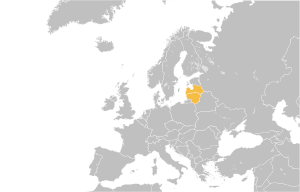
The Balts or Baltic peoples (Lithuanian: baltai, Latvian: balti) are a group of peoples inhabiting the eastern coast of the Baltic Sea who speak Baltic languages. Among the Baltic peoples are modern-day Lithuanians (including Samogitians) and Latvians (including Latgalians) — all East Balts — as well as the Old Prussians, Curonians, Sudovians, Skalvians, Yotvingians and Galindians — the West Balts — whose languages and cultures are now extinct, but made a large influence on the living branches, especially on literary Lithuanian language.
The Balts are descended from a group of Proto-Indo-European tribes who settled the area between the lower Vistula and southeast shore of the Baltic Sea and upper Daugava and Dnieper rivers, and which over time became differentiated into West and East Balts. In the fifth century CE, parts of the eastern Baltic coast began to be settled by the ancestors of the Western Balts, whereas the East Balts lived in modern-day Belarus, Ukraine and Russia. In the first millennium CE, large migrations of the Balts occurred. By the 13th and 14th centuries, the East Balts shrank to the general area that the present-day Balts and Belarusians inhabit. (Full article...) -
Image 9
The Kingdom of Lithuania was a sovereign state that existed from the 17 July 1251 until the death of the first crowned king of Lithuania, Mindaugas, on 12 September 1263. Mindaugas was the only Lithuanian monarch crowned king with the assent of the Pope and the head of the first catholic Lithuanian state. The formation of the kingdom is widely regarded as a partially successful attempt at unifying all surrounding Baltic tribes, including the Old Prussians, into a single unified state under a common king.
Other monarchs of Lithuania were referred to as grand dukes, kings or emperors in extant foreign written sources as the size of the realm and their power expanded or contracted. This practice can be compared to that of British, Japanese and many other monarchs who are known as kings or emperors in spite of not being crowned with the assent of the Pope. Because Lithuania was pagan in the 13th century, Lithuanian monarchs were not granted the title of a Catholic monarch even though extant Christian sources referred to Lithuanian rulers as kings or emperors regardless of their religious affiliation. For instance, Gediminas titled himself King of Lithuania and Rus, and Duke of Semigalia. The Pope also addressed him as King. (Full article...) -
Image 10

The Vilna Governorate was a province (guberniya) of the Northwestern Krai of the Russian Empire. In 1897, the governorate covered an area of 41,907.9 square kilometres (16,180.7 sq mi) and had a population of 1,591,207 inhabitants. The governorate was defined by the Minsk Governorate to the south, the Grodno Governorate to the southwest, the Suwałki Governorate to the west, the Kovno and Courland Governorates to the north, and the Vitebsk Governorate to the east. The capital was located in Vilna (Vilnius). The city also served as the capital of Vilna Governorate-General, which existed until 1912. The area roughly corresponded to the Vilnius Region, which was later occupied by Germany, Bolsheviks, and Poland. (Full article...) -
Image 11
King Stanisław August Poniatowski unwillingly presided over the dissolution of the Polish–Lithuanian Commonwealth
The History of the Polish–Lithuanian Commonwealth (1764–1795) is concerned with the final decades of existence of the Polish–Lithuanian Commonwealth. The period, during which the declining state pursued wide-ranging reforms and was subjected to three partitions by the neighboring powers, coincides with the election and reign of the federation's last king, Stanisław August Poniatowski.
During the later part of the 18th century, the Commonwealth attempted fundamental internal reforms. The reform activity provoked hostile reaction and eventually military response on the part of the surrounding states. The second half of the century brought improved economy and significant growth of the population. The most populous capital city of Warsaw replaced Danzig (Gdańsk) as the leading trade center, and the role of the more prosperous urban strata was increasing. The last decades of the independent Commonwealth existence were characterized by intense reform movements and far-reaching progress in the areas of education, intellectual life, arts and sciences, and especially toward the end of the period, evolution of the social and political system. (Full article...) -
Image 12Early dukes of Lithuania (including Samogitia) reigned before Lithuanians were unified by Mindaugas into a state, the Grand Duchy of Lithuania. While the Palemonids legend provides genealogy from the 10th century, only few dukes were mentioned by contemporary historical sources. All of them were mentioned in written sources the 13th century. Data about them is extremely scarce and is usually limited to few brief sentences. The primary sources are the Chronicle of Henry of Livonia and Hypatian Codex. (Full article...)
-
Image 13
The Act of Independence of Lithuania (Lithuanian: Lietuvos Nepriklausomybės Aktas) or the Act of February 16th, also the Lithuanian Resolution on Independence (Lithuanian: Lietuvos Nepriklausomybės Nutarimas), was signed by the Council of Lithuania on February 16, 1918, proclaiming the restoration of an independent State of Lithuania, governed by democratic principles, with Vilnius as its capital. The Act was signed by all twenty representatives of the Council, which was chaired by Jonas Basanavičius. The Act of February 16 was the result of a series of resolutions on the issue, including one issued by the Vilnius Conference and the Act of January 8. The path to the Act was long and complex because the German Empire exerted pressure on the Council to form an alliance. The Council had to carefully maneuver between the Germans, whose troops were present in Lithuania, and the demands of the Lithuanian people.
The immediate effects of the announcement of Lithuania's re-establishment of independence were limited. Publication of the Act was prohibited by the German authorities, and the text was distributed and printed illegally. The work of the Council was hindered, and Germans remained in control over Lithuania. The situation changed only when Germany lost World War I in the fall of 1918. In November 1918 the first Cabinet of Lithuania was formed, and the Council of Lithuania gained control over the territory of Lithuania. Independent Lithuania, although it would soon be battling the Wars of Independence, became a reality. (Full article...) -
Image 14The Soviet Union (USSR) occupied most of the territory of the Baltic states in its 1944 Baltic Offensive during World War II. The Red Army regained control over the three Baltic capitals and encircled retreating Wehrmacht and Latvian forces in the Courland Pocket where they held out until the final German surrender at the end of the war. (Full article...)
-
Image 15

Volunteers of the Lithuanian Army heading to the war in Vilkaviškis, 1919
The Lithuanian Wars of Independence, also known as the Freedom Struggles (Lithuanian: Laisvės kovos), refer to three wars Lithuania fought defending its independence at the end of World War I: with Bolshevik forces (December 1918 – August 1919), Bermontians (October 1919 – December 1919), and Poland (August 1920 – November 1920). The wars delayed international recognition of independent Lithuania and the formation of civil institutions. (Full article...)
Selected politics article
-
Image 1
The president of the Republic of Lithuania (Lithuanian: Lietuvos Respublikos Prezidentas) is the head of state of the Republic of Lithuania. The president directs and appoints the executive branch of the Government of Lithuania, represents the nation internationally and is the commander-in-chief of the Lithuanian Armed Forces. The president is directly elected by the citizens of Lithuania for a five-year term, with the office holder limited to serving two terms consecutively. The current president is Gitanas Nausėda who assumed office on July 12, 2019. (Full article...) -
Image 2
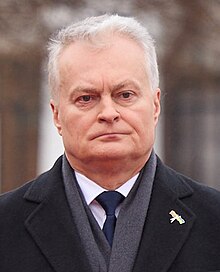
Gitanas Nausėda (/ɡɪˈtɑːnəs naʊˈsɛdə/; Lithuanian: [ɡʲɪˈtˠɐnˠɐs nˠɐʊˈsʲeːdˠɐ]; born 19 May 1964) is a Lithuanian politician, economist, and banker who is serving as the ninth and incumbent president of Lithuania since 2019. Born in Klaipėda, Nausėda graduated from Vilnius University with an economics degree in 1987. He was director of monetary policy at the Bank of Lithuania from 1996 to 2000 and chief economist to the chairman of SEB bankas from 2008 to 2018. (Full article...) -
Image 3
Election campaign poster in Vilnius
The 2014 European Parliament election in Lithuania was an election of the delegation from Lithuania to the European Parliament in 2014. It was part of the wider 2014 European election. (Full article...) -
Image 4
The Supreme Court of the Republic of Lithuania (Lithuanian: Lietuvos Respublikos Aukščiausiasis Teismas) is the only court of cassation in the Lithuania for reviewing effective judgements and rulings passed by the courts hearing criminal cases at the first and appeal instances as well as decisions and rulings in civil cases passed by the courts of appeals. It is the highest court of cassation, but it cannot interpret the constitution, since that is under the jurisdiction of the Constitutional Court of Lithuania. The current President of the Supreme Court of Lithuania is Danguolė Bublienė. (Full article...) -
Image 5
Danguolė Bublienė is a Lithuanian lawyer and judge who is currently serving as the President of the Supreme Court of Lithuania. She is the first woman to hold this position in the history of the Lithuanian judiciary. Her career spans various legal roles, where she has earned recognition for her expertise in civil law and her commitment to ensuring justice. (Full article...) -
Image 6
Seimas Palace (Lithuanian: Seimo rūmai) is the seat of the Seimas, the Lithuanian parliament. It is located in Lithuania's capital Vilnius. (Full article...) -
Image 7In Lithuania, a public election committee (Lithuanian: visuomeninis rinkimų komitetas) is an organized group of voters outside of political parties which participates in local or European Parliament elections. (Full article...)
-
Image 8

Seniūnijos of Lithuania
A seniūnija (in English: eldership, elderate, ward, parish, or subdistrict) is the smallest administrative division of Lithuania. An eldership may comprise a very small region consisting of few villages, one single town, or a part of a big city. Elderships vary in size and population depending on their location and nature. A few elderships make up a municipality. Šilainiai, Dainava, Verkiai, Žirmūnai and Pašilaičiai are the most populous elderates, with population counts over 40,000, around twice the population of some entire municipalities. (Full article...) -
Image 9

Presidential elections were held in Lithuania on 11 May 2014, with a second round held on 25 May between the top two candidates from the first round. In the second round, incumbent President Dalia Grybauskaitė was re-elected with 58% of the vote. Second round took place alongside the 2014 European elections. (Full article...) -
Image 10

Constitutional Court of the Republic of Lithuania (in Lithuanian: Lietuvos Respublikos Konstitucinis Teismas) is the constitutional court of the Republic of Lithuania, established by the Constitution of the Republic of Lithuania of 1992. It began the activities after the adoption of the Law of Constitutional Court of the Republic of Lithuania on 3 February 1993. Since its inception, the court has been located in Vilnius. (Full article...) -
Image 11

The Seimas of the Republic of Lithuania (Lithuanian: Lietuvos Respublikos Seimas), or simply the Seimas (/ˈseɪməs/ SAY-məs; Lithuanian: [ˈsɛɪˑmɐs]), is the unicameral legislative body of the Republic of Lithuania. The Seimas constitutes the legislative branch of government in Lithuania, enacting laws and amendments to the Constitution, passing the budget, confirming the Prime Minister and the Government and controlling their activities. (Full article...) -
Image 12
Gintaras Goda (Lithuanian: [ˈɡʲɪn̪t̪ɐrɐs ˈɡʲɐ̂ːd̪ɐ]; born 13 June 1965) is a Lithuanian judge, legal researcher, comparative criminal procedure expert and professor at the Faculty of Law of Vilnius University who is currently serving as President of the Constitutional Court of Lithuania since 2023. He had been a Judge of the Supreme Administrative Court of Lithuania from 2002 to 2005 and was Judge of the Supreme Court of Lithuania from 2005 to 2017. (Full article...) -
Image 13
The Speaker of the Seimas (Lithuanian: Seimo pirmininkas, literally translated as Chairman of the Seimas) is the presiding officer of the Seimas, the parliament of Lithuania. The speaker and deputy speakers are elected by the members of the Seimas during the session. (Full article...) -
Image 14There have been fifteen referendums in Lithuania since it declared independence from the Soviet Union on 11 March 1990. Because of strict requirements, only four referendums have been successful. Older Lithuanian laws required that more than half of all registered voters (not half of voters who participate) would vote in support of a proposal for it to become a binding obligation to the government. In 2002, this requirement was lowered to one third of all registered voters. (Full article...)
-
Image 15This article lists political parties in Lithuania.
Lithuania has a multi-party system with numerous political parties, in which no one party often has a chance of gaining power alone, and parties must work with each other to form coalition governments. As of October 2024[update], there are 22 active political parties, one party undergoing formal registration, one inactive political party, and four political parties that are in the process of disestablishment registered with the Ministry of Justice. (Full article...)
Selected biography
-
Image 1
Robert Lee Zemeckis (born May 14, 1952) is an American filmmaker known for directing and producing a range of successful and influential movies, often blending cutting-edge visual effects with storytelling. He has received several accolades including an Academy Award and a Golden Globe Award as well as nominations for five British Academy Film Awards and a Daytime Emmy Award.
Zemeckis started his career directing the comedy films I Wanna Hold Your Hand (1978), Used Cars (1980), and Romancing the Stone (1984). He gained prominence directing the science-fiction comedy Back to the Future trilogy (1985–1990), the fantasy comedy Who Framed Roger Rabbit (1988), and the comedy-drama Forrest Gump (1994), the latter of which won Academy Awards for Best Picture and Best Director. (Full article...) -
Image 2
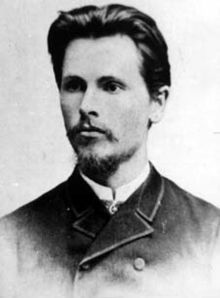
Vincas Kudirka
Vincas Kudirka (Polish: Wincenty Kudyrko; 31 December [O.S. 19 December] 1858 – 16 November [O.S. 4 November] 1899) was a Lithuanian poet and physician, and the author of both the music and lyrics of the Lithuanian national anthem, "Tautiška giesmė". He is regarded in Lithuania as a national hero. Kudirka used the pen names V. Kapsas, Paežerių Vincas, Vincas Kapsas, P.Vincas, Varpas, Q.D, K., V.K, Perkūnas.
Kudirka was born in Paežeriai, in the Augustów Governorate of Congress Poland (present-day Lithuania). He began studying history and philosophy in Warsaw in 1881, but changed his major to medicine the following year. During his studies, he was a member of the revolutionary organization Great Proletariat, for which he was arrested and expelled from the university in 1885. He was reinstated as a student in 1887. He graduated in 1889, and worked as a country doctor in Šakiai and Naumiestis. (Full article...) -
Image 3

Vytautas Šapranauskas (19 April 1958 – 18 April 2013) was a Lithuanian comedy and drama actor of theatre and cinema, and an anchor of TV programs. According to the chairman of the Lithuanian Union of Actors, he was one of Lithuania's most talented actors, both in comedy and drama.
In 1980, he graduated from the Lithuanian Academy of Music and Theatre. Until 1990, he was affiliated with the Russian Drama Theatre, and from 1990 he was with the Vilnius Small Theatre [lt].
He acted in a number of films, both during the Soviet times and in independent Lithuania. (Full article...) -
Image 4
Stasys Eidrigevičius (born 24 July 1949 in Mediniškiai, Lithuania) is a painter and graphic artist. (Full article...) -
Image 5
Jurgis Baltrušaitis (2 May 1873 – 3 January 1944) was a Lithuanian symbolist poet and translator, who wrote in Lithuanian and Russian and was an exponent of iconology. He was the father of art historian and critic Jurgis Baltrušaitis Jr. (Full article...) -
Image 6
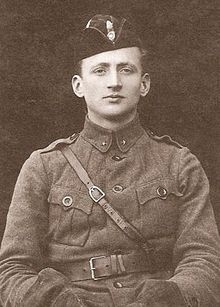
Jurgis Dobkevičius (23 March 1900 – 8 June 1926) was a pioneering aviator and aircraft designer in interwar Lithuania.
Educated in Russia, Dobkevičius joined the Lithuanian Army in 1919. During the Polish–Lithuanian War and the Żeligowski's Mutiny in July–November 1920, Dobkevičius flew 21 missions. After about 400 flight hours, he retired from active military service in 1923 in order to study at L'Ecole Superieure d'Aeronautique in Paris. (Full article...) -
Image 7
Ingeborga Dapkūnaitė (born 20 January 1963) is а Lithuanian actress and television presenter. Known for both her screen and stage performances, she has gained recognition for featuring in films such as Burnt by the Sun (1994) and Katya Ismailova (1994), which won her the Nika Award for Best Actress. Dapkūnaitė was also credited in Mission: Impossible (1996), Seven Years in Tibet (1997), Emily Young's debut Kiss of Life (2003), and Okkupert (2015–2019).
Dapkūnaitė performed in theaters in Lithuania, the United Kingdom, United States, and Russia, including Steppenwolf Theatre, Shaftesbury Theatre, The Old Vic, Hampstead Theatre, Theatre of Nations, and more. She has a long-lasting professional partnership with John Malkovich, they worked together on numerous theatrical productions. (Full article...) -
Image 8Iveta Lukošiūtė (born 29 June 1980) is a Lithuanian dancer and choreographer. She is best known for appearing as a professional dancer on Strictly Come Dancing between 2012 and 2014. (Full article...)
-
Image 9Marcelijus Teodoras Martinaitis (1 April 1936 – 5 April 2013) was a Lithuanian poet, essayist, translator. (Full article...)
-
Image 10
Oscar Vladislas de Lubicz Milosz (Lithuanian: Oskaras Milašius; Polish: Oskar Władysław Miłosz) (28 May 1877 or 15 May 1877 – 2 March 1939) was a French language poet, playwright, novelist, essayist and representative of Lithuania at the League of Nations. His literary career began at the end of the nineteenth century during la Belle Époque and reached its high point in the mid-1920s with the books Ars Magna and Les Arcanes, in which he developed a highly personal and dense Christian cosmogony comparable to that of Dante in The Divine Comedy and John Milton in Paradise Lost. A solitary and unique twentieth-century metaphysician, his poems are visionary and often tormented. He was a distant cousin of Polish writer Czesław Miłosz, winner of the Nobel Prize for literature in 1980. (Full article...) -
Image 11Martynas Pocius representing Lithuania national team
Martynas Pocius (born 28 April 1986) is a Lithuanian former professional basketball player. He was also a member of the Lithuanian national basketball team. (Full article...) -
Image 12
Kazimieras Būga (Lithuanian pronunciation: [kɐˈzʲɪˈmʲiərɐs buːˈɡɐ]; November 6, 1879 – December 2, 1924) was a Lithuanian linguist and philologist. He was a professor of linguistics, who mainly worked on the Lithuanian language.
He was born at Pažiegė, near Dusetos, then part of the Russian Empire. Appointed as personal secretary to Lithuanian linguist Kazimieras Jaunius he showed great interest in the subject, and during the period 1905-12 studied at Saint Petersburg State University. After that, he continued his work on Indo-European language under the supervision of Jan Niecisław Baudouin de Courtenay. He later moved to Königsberg to continue his studies under the direction of Adalbert Bezzenberger. In 1914 he received a master's degree in linguistics. (Full article...) -
Image 13

Antanas Samuolis (born Antanas Samulevičius; 3 June 1899 – 9 February 1942) was a prominent Lithuanian interwar expressionist painter. Considered one of the most capable students of Justinas Vienožinskis [lt], Samuolis's paintings have had a significant impact on Lithuanian art of the first half of the 20th century.
Samuolis is the uncle of painter Raimundas Samulevičius through his brother and his wife and painter Stasė Samulevičienė [lt]. (Full article...)
Associated Wikimedia
The following Wikimedia Foundation sister projects provide more on this subject:
-
Commons
Free media repository -
Wikibooks
Free textbooks and manuals -
Wikidata
Free knowledge base -
Wikinews
Free-content news -
Wikiquote
Collection of quotations -
Wikisource
Free-content library -
Wikiversity
Free learning tools -
Wikivoyage
Free travel guide -
Wiktionary
Dictionary and thesaurus
















![Image 16The earliest known Lithuanian glosses (between 1520 and 1530) written in the margins of Johann Herolt book Liber Discipuli de eruditione Christifidelium. Words: teprÿdav[ſ]ʒÿ (let it strike), vbagÿſte (indigence). (from Lithuania)](http://up.wiki.x.io/wikipedia/commons/thumb/f/f6/The_earliest_known_Lithuanian_glosses_%28~1520%E2%80%931530%29%2C_words_%28tepridau%C5%BEia%2C_ubagyst%C4%97%29.jpg/120px-The_earliest_known_Lithuanian_glosses_%28~1520%E2%80%931530%29%2C_words_%28tepridau%C5%BEia%2C_ubagyst%C4%97%29.jpg)


















































